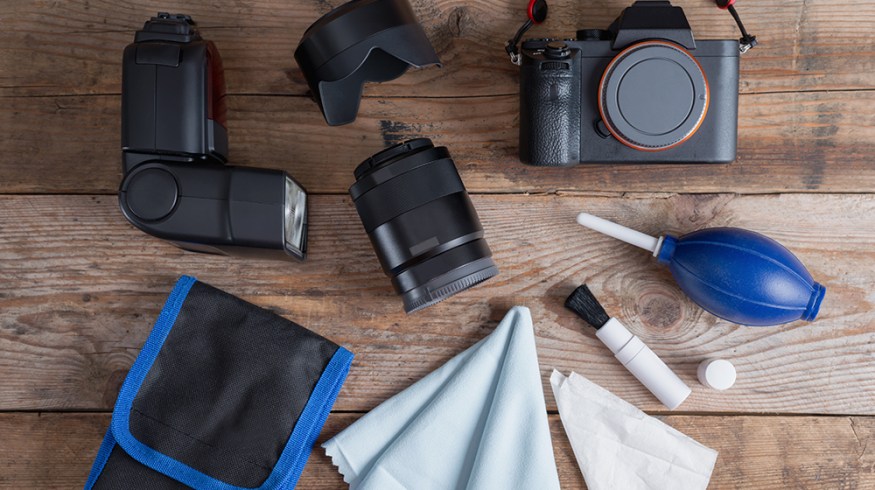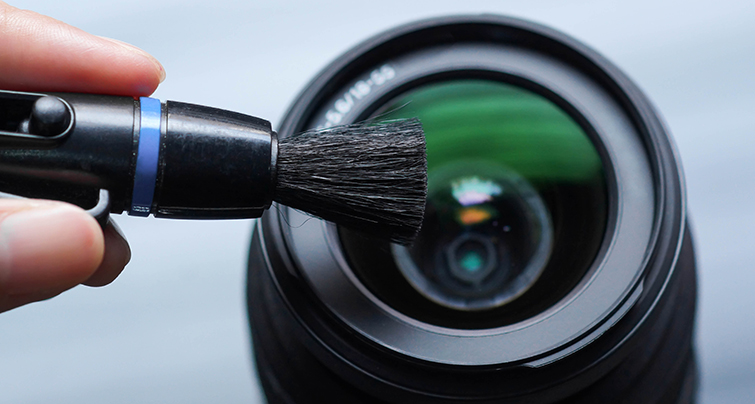
A Guide to Cleaning Lenses and Camera Sensors
You can’t keep your camera pristine and clean forever. Dust, dirt and smudges will speckle your camera from time to time. Here’s how you can clean your camera up and get back in the game.
Cover image via Shutterstock
We’ve all been there (case in point). You’re out on a shoot and someone jumps in a rain puddle and it splashes your camera. You ask your friend to pass you a lens and they grab it by the glass leaving a huge smudge. Regardless of the circumstances, there will come a time where you will need to clean your lens to remove smudges or debris. Luckily, as long as nothing is scratched or shattered, there are plenty of tools and resources available to help you out. Here’s a few recommended methods.
How to Clean Lenses
 Image via Shutterstock
Image via Shutterstock
Lenses are very different instruments from your camera sensor. Lenses are exposed to the elements when shooting and are highly susceptible to getting dirtied up. The manufacturers also made them with this in mind, so working to clean lenses is a much different process than your sensor, which is meant to be protected at all times. The majority of lens dirtiness can be alleviated with some simple items that can (and should) be easily stored in your camera bag.
Use Filters (UV or ND)
 Image via Shutterstock
Image via Shutterstock
Your first preferred method for maintaining clean glass: protect your lenses with filters. Albeit, you’ll need to clean your filters just as often, but it will protect the actual lens from ever getting dirtied up. Depending on your shoot, you can use either an ND Filter (or GND if you’re fancy), or you can use a UV Filter for protection and slightly improved clarity.
Lens Fluid and Cloth
 Image via Shutterstock
Image via Shutterstock
The next preferred method (and first actual) would be to use a lens cloth combined with your camera-recommended lens cleaner. You can also use disposable lens tissues in lieu of the cloth, as long as its properties are comparable to microfiber. Residual oil remover fluids are available online or at your local camera store and can be purchased pretty cheaply.
Lens Wipes

You can also buy lens wipes (like these Zeiss Pre-Moistened Lens Cleaning Wipes) as they will be the most pristine in their individual packaging. They will also be the most expensive — so with budgeting in mind, it may or may not be a better choice than lens fluid and cloth.
How to Clean Sensors
 Image via Shutterstock
Image via Shutterstock
Sensor cleaning is another story altogether. Damaging (or dirtying beyond simple repair) your sensor can be quite an investment depending on your camera. That being said, your camera manufacturers know this and the majority of cameras have built-in sensor cleaning mechanisms. The Canon 5D, for example, will auto-clean its sensor whenever you turn it off. Cameras auto-clean either by shaking/vibrating very slightly and quickly and/or negatively charging the air around the sensor to clean the dust off. If you do need to dive in, it’s best to try dry methods first before putting any foreign substances or pressures on the sensor.
Blowers
 Image via Shutterstock
Image via Shutterstock
Blowers are the recommended way of cleaning a sensor at first. Using a blower, not blowing with your mouth, is preferred, as you’ll want the air to be clear of liquid or anything else you may have in your breath. Would not recommend using compressed air either, as those can have propellents and lubricants that could mess up your sensor.
Brushes
 Image via Shutterstock
Image via Shutterstock
The next step in the line of sensor cleaning succession would be to try using a brush to (ever so) lightly remove any dust or dirt off of the sensor. Make sure you use a clean sensor-designed brush that doesn’t have any hard hair that might scratch or do any damage to the sensor.
Sensor Cleaning Swabs

You can also use sensor cleaning swabs. Like the lens wipes, the swabs usually come individually packed which will add up in cost in the long run — but for the higher price point, you do get the best results. The swabs take only one or two drops of solution and each side is used in one smooth, soft stroke across the sensor. You can watch this video for a better demonstration.
Check Your Sensor and Lenses With a Reference Photo
The ultimate way to see if your sensor and lenses are clear after cleaning is to take a reference photo. Set your camera to a low aperture like f/22 and take a photo against a pure white background. You can move your camera slightly to create a blur so that specks stand out. You can check it through your viewfinder or upload it and blow it up on a computer screen to check for any dirt or dust.

Once you’ve checked your work through a clean reference photo, your job is done. The majority of these cleaning tools can fit quite easily and lightly in your bag. Just imagine — you may never have to do a shirt wipe again.
Have any other tips or tricks for cleaning your lenses and sensors? Let us know in the comments below!





